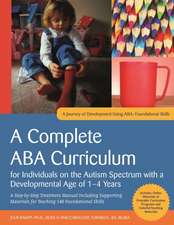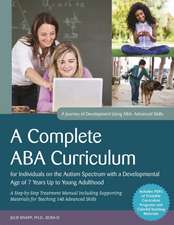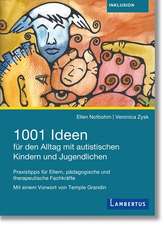A Complete ABA Curriculum for Individuals on the Autism Spectrum with a Developmental Age of 3-5 Years
Autor Carolline Turnbull, Julie Knappen Limba Engleză Paperback – 30 sep 2017
Containing everything needed to teach beginning skills such as imitation, visual spatial awareness, expressive and receptive language skills and skills of daily living, this comprehensive ABA curriculum has been developed for individuals on the autism spectrum with a developmental age of approximately 3-5 years.
Evidence-based, the resource guides instructors step-by-step through using ABA to teach over 140 beginning skills. The program can be individualized to meet the needs and interests of the individual, and instructions are given on how to do this. The accompanying online downloadable content contains the teaching materials needed to implement the program, including over 1000 color picture cards, handy printable copies of the curriculum programs, data forms and checklists. The authors also provide guidance on creating an effective ABA teaching environment, as well as a wealth of practical teaching strategies for ensuring therapy success. This is an unparalleled resource for professionals working with children with ASDs who are looking for a robust and ready-to-implement ABA curriculum. It will be a valuable tool for behaviour analysts, teachers, psychologists, occupational therapists and students in these fields, as well as to parents working with professionals to implement an ABA program.Preț: 451.52 lei
Preț vechi: 611.96 lei
-26% Nou
86.40€ • 90.21$ • 71.51£
Carte disponibilă
Livrare economică 14-28 martie
Livrare express 28 februarie-06 martie pentru 89.80 lei
Specificații
ISBN-10: 1785929968
Pagini: 480
Dimensiuni: 216 x 280 x 28 mm
Greutate: 1.26 kg
Editura: JESSICA KINGSLEY PUBLISHERS
Descriere
Containing everything needed to teach beginning skills such as imitation, visual spatial awareness, expressive and receptive language skills and skills of daily living, this comprehensive ABA curriculum has been developed for individuals on the autism spectrum with a developmental age of approximately 3-5 years. Evidence-based, the resource guides instructors step-by-step through using ABA to teach over 140 beginning skills. The program can be individualized to meet the needs and interests of the individual, and instructions are given on how to do this.
The accompanying online downloadable content contains the teaching materials needed to implement the program, including over 1000 color picture cards, handy printable copies of the curriculum programs, data forms and checklists. The authors also provide guidance on creating an effective ABA teaching environment, as well as a wealth of practical teaching strategies for ensuring therapy success. This is an unparalleled resource for professionals working with children with ASDs who are looking for a robust and ready-to-implement ABA curriculum.
It will be a valuable tool for behaviour analysts, teachers, psychologists, occupational therapists and students in these fields, as well as to parents working with professionals to implement an ABA program.







